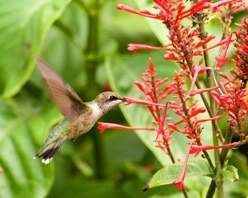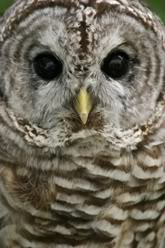Hummingbirds and Owls
By Juliet Marillier | February 28, 2007 |
 Kathleen and Therese step in for a second to officially welcome Juliet Marillier to the forum. This is her first post.
Kathleen and Therese step in for a second to officially welcome Juliet Marillier to the forum. This is her first post.
The hummingbird is constantly in motion, a high energy creature, nervously darting from flower to flower, desperate to maintain enough nutrition to keep herself going at top speed. This flower, now this one, no, maybe that one, oops, here comes a predator…
The owl perches very still. She watches. She swoops. She returns to feed. Efficient and focused, she’s a planner.
I discovered only recently that some well-regarded and successful novelists have hummingbird muses. Such writers begin their books with no clear idea of where the story is going. Some reasons I’ve heard for this approach are that the author likes to be surprised by the characters, that she prefers to let the story follow its own path, and that she just can’t write any other way. This is sometimes called flimmering (flimmer = to flicker or move erratically.)
What astonishes me about this is not so much the fact that people can write an extended piece this way, but that they can produce one that apparently works on a structural level. It seems a little like building a house by starting with the brick in the bottom left hand corner and working on upwards. My muse is definitely an owl – I don’t begin to write the novel until I have the framework firmly in place. I generally do a long outline, a shorter synopsis and a chapter plan before I start on the book proper.
You’ll read in my bio for this site that I view myself as an intuitive writer. How is this possible when I sound like a complete control freak? Well, all the preliminary planning allows the subsequent writing of the book to flow freely and not be held up by thorny structural issues along the way. I’d normally do something like this:
1. Concept, setting, themes, characters take shape in my mind over a period
2. Research (for a historical fantasy this can be substantial)
3. Write long, fairly detailed outline (generally a lot of brainstorming and rewriting involved)
4. Write synopsis (shorter and tighter) if required
5. Write chapter plan – forming the outline into a shape that is artistically and dramatically satisfying. If things don’t work, they get changed. The chapter plan also helps keep the word count on track
6. Write book
Of course I change things as I go. Nothing is set in stone. In particular, I refine and develop the remaining part of the chapter plan further and further as I progress through the novel. But I rarely alter major plot elements while writing (such as deciding A does not marry B after all, or C falls off a cliff instead of saving the world.) Owls don’t need to do so many drafts, because all that planning means the first draft is more ‘finished’ than a hummingbird’s first draft. At least, that’s how it seems.
We all know the process doesn’t end with the completion of the manuscript. There’s re-drafting and then the editorial stuff, which takes ages. More on that another time.
Getting bogged down in your novel because of inadequate forward planning (or, in some cases, no planning) is a very, very frequent problem for inexperienced writers. People can change from hummingbird to owl and make it work. In my writers’ group, which contains people from both camps and several genres, we now work through our outlines, synopses and chapter plans together and everyone agrees on the value of the process.
Sounds a little tedious? It’s certainly not as romantic as letting the words gush out spontaneously, and for inexperienced writers the idea that a writer’s life is mostly self-discipline and hard work can be a turn-off. To anyone who has the ability to produce a good novel by sitting down at the keyboard and just letting it flow, my congratulations!
Postscript: When I was looking up flimmer in the Shorter Oxford, I found the lovely word flindermouse. It’s a variant of flittermouse, an old term for a bat.
Photo credits
Hummingbird:
Photographer: Tim Fulbright
Agency: Dreamstime.com
Owl image also supplied by Dreamstime.com










welcome, juliet! what a lovely blog that i get to sleep on tonight. hmmmmm, am i an owl or a hummingbird???? i think i’m an owl, as i am slow to act until i have it all sorted out. i shall have to think about it some more, though!!
I definitely have the spirit of a hummingbird, but I’m learning owl-ish ways.
Welcome, Juliet!
I am a hummingbird dressed in owl clothing. Or is it an owl dressed as a hummingbird? Hmmm.
Flimmer, flittermouse, flindermouse. I’m going to have to find a way to work these in my current wip.
I think you’ve just given us the keys to the candystore in terms of learning how to balance between structure and inspiration. I know I began this journey as a hummingbird, and after painful years of writing and flailing around, am evolving into an owl. It certainly saves time in the end to have your framework already laid out. I’m going to have to try out the chapter plan method too. Currently I break a chapter when it “feels” right. Hoo boy.
Even as a natural owl, I find outlines and chapter plans a chore to write, but I’ve seen this method work wonders for people who struggle with structure or flounder in the middle of their book. I would always put a rider on my own advice, and that is that there’s no ‘correct’ or ‘best’ way to write a novel (or compose a piece of music or create a sculpture.)
Thank you for writing such an interesting post!
I’m writing my first novel and I am still deep into the editing stages. I am definitely a hummingbird that tries to act like an owl! I did outline this story, but as I re-wrote it, it developed on its own. Its been doing that for thirteen years (over half my life!). Thanks for giving me something to think about– my writing habits keep changing every day and I can’t wait until I can use more owl-like ways!
Normally my stories start out of the blue. But then again, I don’t write books (yet), only short stories.
The one I am now writing does have a plot outline by the way. The whole story came flashing by and I wrote it down immediately.
Still I find it hard to come with the right words to write the actual story.
Flindermouse. In Dutch it is Vleermuis and in German Fledermaus (it is also an opera I think). All similar words derived from the same source. :)
I must be schizophrenic because I alternate between preplotting and freewheeling. What do you get when you cross a hummingbird with an owl?????
A kestrel?
(small Old World falcon that hovers in the air against a wind)
Ziburan,
That is perfect! I love birds of prey and hovering against the wind is not a bad metaphor for my current writing status either…. Thank you. :)
As a former flimmery flittermouse who has now seen the error of her ways, I’d like to put in a word for both schools of thought – or styles of Muse:-)
I would love to be able to flimmer my way through a novel, but three years of trying had proved I can’t. However, I had to rewrite the first book of my trilogy several times before I even knew what the storyline was!
With help and encouragment from other writers, I’ve come to realise that the best way for me is to write as much of the plot as I can, show it to trusted critters and then harvest their ideas on how to round the story out – and, indeed, how to turn the story into a plot.
With this method in train I now have high hopes for my trilogy:-)
AS more of a hummingbird I have to say I wish I was an owl, but since I am still at university I simply don’t have the time to plan everythung out. I have always written around things, homework mainly and so have become very accustomed to writing in short bursts. I have recently taken on the habit of going to Apollo bay as often as I can and writing for a solid week, but when you’re worrying about document exercises and essays, its difficult. Any advice?
If I were you, Michelle, I would be concentrating on writing short fiction rather than long until you’ve finished your studies. It can be very hard to keep the creative flow going when writing can only happen in short bursts.
When time is limited the last thing we want to be working on is a synopsis or chapter plan – as soon as a writing opportunity opens up, we’re desperate to plunge into the story itself. It sounds as if you are pretty good at that.